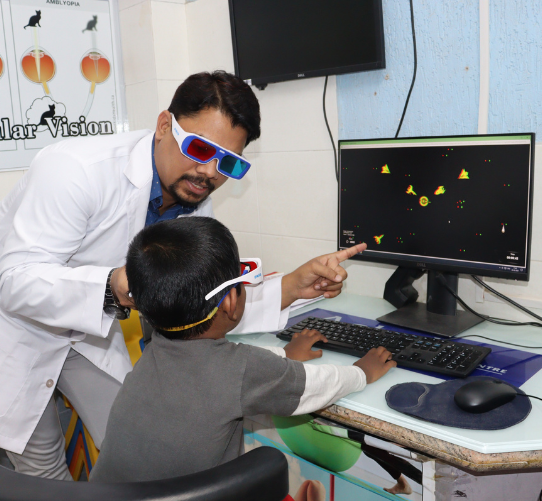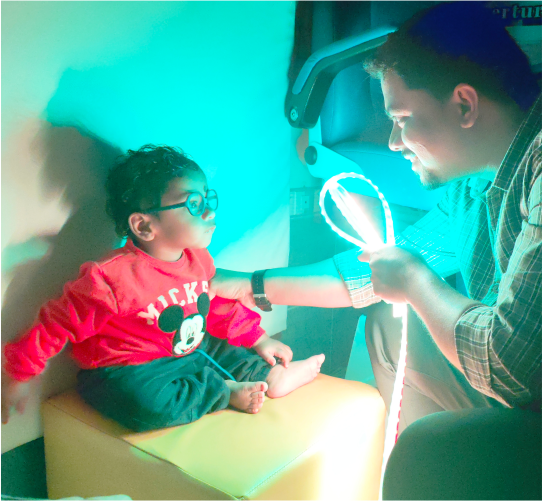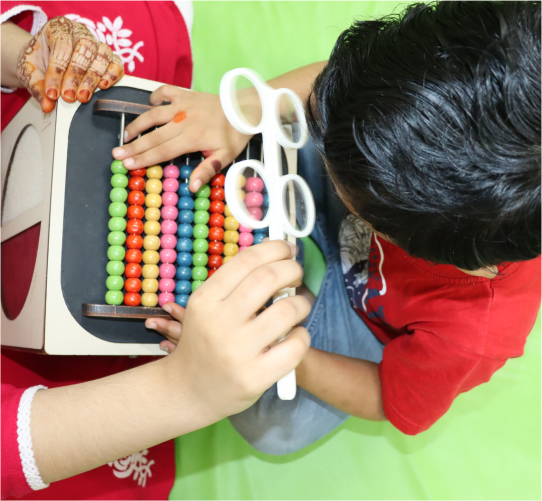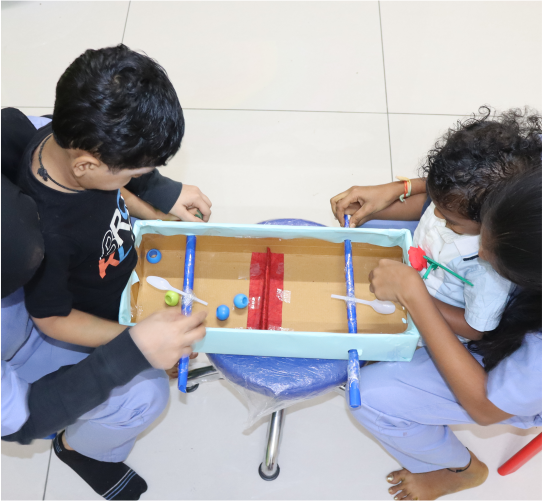Vision Therapy
“Seeing Beyond Limits: Discover Clarity and Confidence with Vision Therapy!”
Vision Therapy
At Ashoka Child Development Centre, we understand that early detection and treatment are crucial, and only by way of regular eye examinations by an eye care professional, especially during early childhood and school-age years, helps to detect and address vision issues promptly.
Ashoka Child development Centre guides parents or caregivers to notice any signs of potential vision problems, such as squinting, rubbing the eyes, or difficulty with coordination. Significantly, early intervention can help address vision issues and support the child’s visual development.
Features
Comprehensive Eye Examinations:
Vision therapies typically begin with a thorough eye examination by an eye care professional to identify any refractive errors, strabismus, amblyopia, or other visual conditions.
Individualized Treatment Plans:
Vision therapy programs are specific to each child’s need. The treatment plan is based on the results of the eye examination and assessments of the child’s visual skills.
Engaging Activities:
Vision therapies for children often incorporate interactive and enjoyable activities to keep the child motivated and interested. Games, puzzles, and other age-appropriate tools may be used.
Binocular Vision Exercises:
Many vision therapies focus on improving binocular vision, which involves the coordinated use of both eyes. Exercises may target convergence, eye teaming, and focusing abilities.
Tracking and Eye Movement Exercises:
Exercises to improve tracking skills and eye movements help enhance the child’s ability to follow moving objects smoothly and accurately.
Visual Processing Activities:
Visual processing exercises may be included to improve skills such as visual discrimination, visual memory, and visual-motor integration. These activities can support academic tasks like reading and writing.
Hand-Eye Coordination Activities:
Activities that involve hand-eye coordination, such as catching or throwing a ball, can be incorporated to improve coordination and spatial awareness.
Sensory Integration:
Some vision therapies may include sensory integration activities to address sensory sensitivities or challenges related to visual processing.
Home-Based Exercises:
Our vision therapists provide exercises or activities for the child to practice at home. Consistency is key to the success of vision therapy.
Progress Monitoring:
Vision therapists regularly monitor the child’s progress to understand the impact of each vision therapy. Changes and adjustments are made based on the child’s response and improvement.
Parental Involvement:
Parents play a crucial role in the vision therapy process. They may be provided with information about their child’s progress and encouraged to support and reinforce therapy activities at home.
Collaboration with Other Professionals:
Vision therapies demand the collaborative efforts of vision therapists, educators, occupational therapists, or paediatricians.
Gradual Increase in Complexity:
Vision therapy activities are often designed to progress gradually in complexity, allowing the child to build and strengthen visual skills over time.
Vision Therapy




Benefits
Improved Visual Acuity:
Vision therapies can help correct refractive errors (nearsightedness, farsightedness, astigmatism), leading to improved clarity of vision.
Enhanced Binocular Vision:
Vision therapy aims to improve the coordination and teamwork of both eyes, leading to better binocular vision. This is crucial for depth perception and accurate visual processing.
Correction of Strabismus:
For children with strabismus (eye misalignment), vision therapy can help train the eyes to work together, reducing or eliminating the misalignment
Treatment of Amblyopia (Lazy Eye):
Vision therapy is often used to address amblyopia by strengthening the weaker eye and encouraging the brain to use both eyes more effectively.
Improved Eye Tracking and Coordination:
Vision therapy exercises target eye movement and coordination, enhancing tracking skills and the ability to smoothly follow objects.
Enhanced Focusing Skills:
Vision therapies include activities to improve the eye’s ability to focus, helping with tasks that require clear and sustained focus at different distances.
Visual Processing Improvement:
Activities aimed at visual processing can enhance skills such as visual discrimination, visual memory, and visual-motor integration. This can have positive effects on academic tasks.
Reduced Eye Strain and Fatigue:
For children experiencing eye strain or fatigue, vision therapy can alleviate these symptoms by improving overall visual comfort and efficiency.
Improved Hand-Eye Coordination:
Vision therapy often includes exercises that enhance hand-eye coordination, which can be beneficial for tasks requiring manual dexterity and precision.
Enhanced Spatial Awareness:
Activities promoting spatial awareness and understanding of one’s surroundings can be part of vision therapy, aiding in activities like navigating spaces and understanding distances.
Sensory Integration:
Vision therapies that incorporate sensory integration activities can help children manage sensory sensitivities and improve overall sensory processing.
Academic Improvement:
Better visual skills can positively impact academic performance, including reading, writing, and other visual tasks involved in learning.
Increased Confidence:
As visual skills improve, children may experience increased confidence in their abilities, both academically and in daily activities.
Prevention of Developmental Delays:
Early intervention with vision therapy can help prevent or address developmental delays associated with visual issues, ensuring that children meet age-appropriate milestones.
Long-Term Visual Health:
Ashok CDC’s vision therapies contribute to long-term visual health by addressing underlying issues and promoting optimal visual development.
